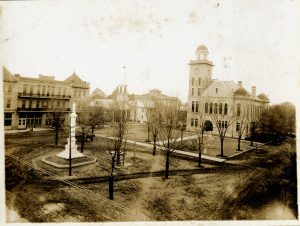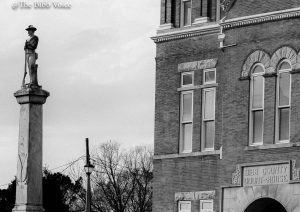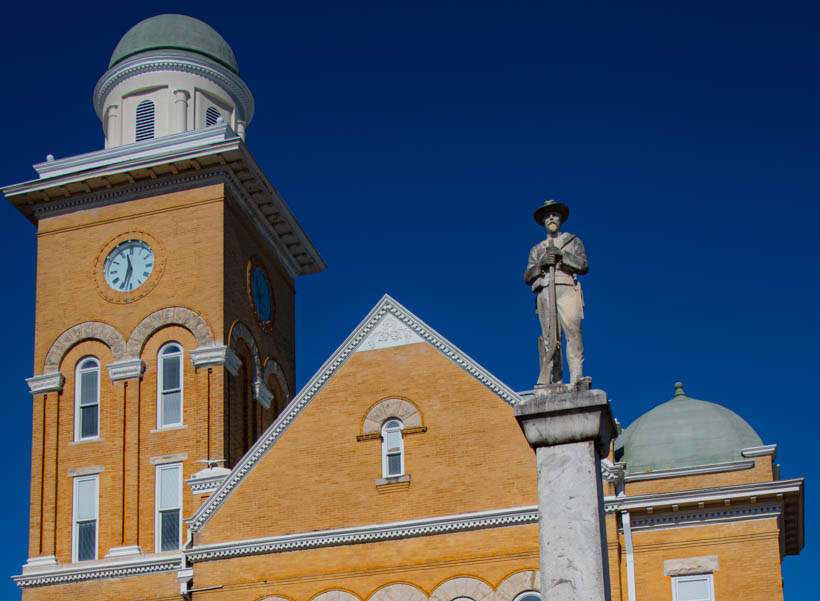 The Bibb Confederate Sentinel has stood a lonely guard post in front of the Bibb County Courthouse since 1910. His present post, near the main entrance, is not his original position, as evidenced by the early photo shown here. When this image was made there were no automobiles in use in the county. The Bibb County confederate monument was placed by the Leonard C. Pratt Chapter of the United Daughters of the Confederacy on April 26, 1910.
The Bibb Confederate Sentinel has stood a lonely guard post in front of the Bibb County Courthouse since 1910. His present post, near the main entrance, is not his original position, as evidenced by the early photo shown here. When this image was made there were no automobiles in use in the county. The Bibb County confederate monument was placed by the Leonard C. Pratt Chapter of the United Daughters of the Confederacy on April 26, 1910.
For the last few years many local historians have been concerned about the future of the Bibb confederate monument as controversies about monuments have raged across the United States and in nearby cities, including Birmingham.
In a ruling that will have statewide consequences the Alabama Supreme Court ruled this week that the city of Birmingham violated Alabama’s monument protection law when it placed a plywood screen around a Confederate monument in Linn Park in August 2017. (Reported by Al.com)
In a 9-0 decision, the justices reversed a lower court ruling in favor of the city. The Supreme Court sent the case back to circuit court with instructions to enter an order that the city broke the law and must pay a $25,000 fine.
The law prohibits local governments from moving, altering, renaming, or otherwise disturbing monuments that have been in place 40 years or more.
The stone base of the Confederate Soldiers and Sailors Monument has been in Linn Park since 1894. The marble shaft was added in 1905, when the Pelham Chapter of the United Daughters of the Confederacy dedicated the monument.
Former Birmingham Mayor William Bell ordered the covering of the monument. Bell took that step after a city councilman asked that the monument be removed.
Attorney General Steve Marshall filed a lawsuit asking the court to declare the covering of the monument violated the Memorial Preservation Act.
In a 44-page opinion today, Justice Tommy Bryan cited legal precedents and concluded that the circuit court erred in ruling that the city had constitutional rights to free speech and due process.
Alabama Attorney General Steve Marshall praised the court’s decision in a statement today.
“The Supreme Court’s ruling is a victory for the Alabama law which seeks to protect historical monuments,” Marshall said. “The City of Birmingham acted unlawfully when it erected barriers to obstruct the view of the 114-year-old Confederate Soldiers and Sailors Monument in Linn Park.”
The Supreme Court ruling also addressed the amount of the fine. The law calls for a $25,000 for each violation of the act. Bryan concluded that the city was subject to a single $25,000 fine, rather than a fine for each day the monument was covered.
Justice Michael Bolin, in a special concurring opinion, questioned whether a fine in that amount was an effective deterrent against violating the law and encouraged the Legislature to revisit the law.
 The Alabama Supreme Court ruling protecting important monuments, statues and other important landmarks has significant importance for Bibb County given the Confederate Memorial monument that stands guard in front of the Bibb County Courthouse.
The Alabama Supreme Court ruling protecting important monuments, statues and other important landmarks has significant importance for Bibb County given the Confederate Memorial monument that stands guard in front of the Bibb County Courthouse.
Karen Williams, a Centreville resident, is still an active member of the Amelia Gayle Gorgas Chapter of the UDC. When contacted for a comment about the future of confederate monuments and Alabama history Mrs. Williams had this to say: “Our past must be honored and preserved. We can’t be politically correct all the time. History cannot be changed to suit a political party, agenda, or populist narrative. Our laws and the rulings of our court systems must be respected even if they are unpopular. We should not allow our ancestral heritage to be destroyed and vilified by the ambitions of contemporary political parties and candidates.”
Roger Brothers, a Bibb County historian and a confederate battle re-enactor has this to say about the court ruling: “As far as law and the court decision, it was a step in the right direction. If it leads to some Americans learning the facts about what those monuments mean and why and how they came to be, the process may lead to less division.”














